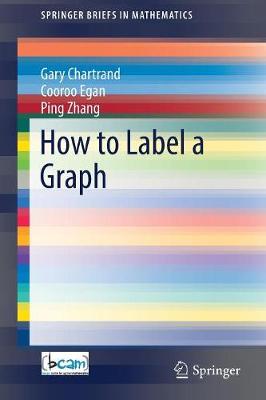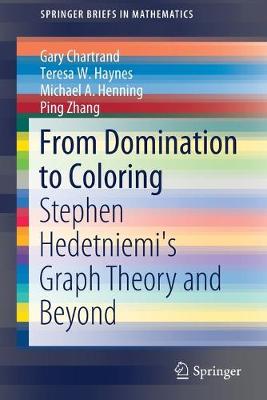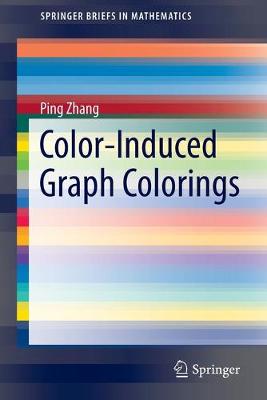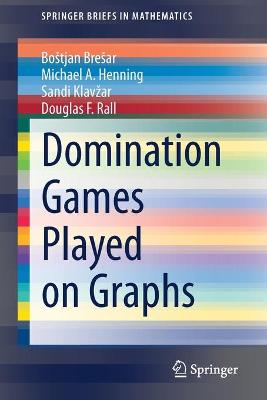SpringerBriefs in Mathematics
6 total works
This book depicts graph labelings that have led to thought-provoking problems and conjectures. Problems and conjectures in graceful labelings, harmonious labelings, prime labelings, additive labelings, and zonal labelings are introduced with fundamentals, examples, and illustrations. A new labeling with a connection to the four color theorem is described to aid mathematicians to initiate new methods and techniques to study classical coloring problems from a new perspective. Researchers and graduate students interested in graph labelings will find the concepts and problems featured in this book valuable for finding new areas of research.
This book describes kaleidoscopic topics that have developed in the area of graph colorings. Unifying current material on graph coloring, this book describes current information on vertex and edge colorings in graph theory, including harmonious colorings, majestic colorings, kaleidoscopic colorings and binomial colorings. Recently there have been a number of breakthroughs in vertex colorings that give rise to other colorings in a graph, such as graceful labelings of graphs that have been reconsidered under the language of colorings.
The topics presented in this book include sample detailed proofs and illustrations, which depicts elements that are often overlooked. This book is ideal for graduate students and researchers in graph theory, as it covers a broad range of topics and makes connections between recent developments and well-known areas in graph theory.
From Domination to Coloring
by Gary Chartrand, Teresa W. Haynes, Michael A. Henning, and Ping Zhang
A comprehensive treatment of color-induced graph colorings is presented in this book, emphasizing vertex colorings induced by edge colorings. The coloring concepts described in this book depend not only on the property required of the initial edge coloring and the kind of objects serving as colors, but also on the property demanded of the vertex coloring produced. For each edge coloring introduced, background for the concept is provided, followed by a presentation of results and open questions dealing with this topic. While the edge colorings discussed can be either proper or unrestricted, the resulting vertex colorings are either proper colorings or rainbow colorings. This gives rise to a discussion of irregular colorings, strong colorings, modular colorings, edge-graceful colorings, twin edge colorings and binomial colorings. Since many of the concepts described in this book are relatively recent, the audience for this book is primarily mathematicians interested in learning some new areas of graph colorings as well as researchers and graduate students in the mathematics community, especially the graph theory community.
During the past several decades, however, there has been some increased interest in investigating graphs possessing a property that is, in a sense, opposite to regularity. It is this topic with which this book deals, giving rise to a study of what might be called irregularity in graphs. Here, various irregularity concepts dealing with several topics in graph theory are described, such as degrees of vertices, graph labelings, weightings, colorings, graph structures, Eulerian and Hamiltonian properties, graph decompositions, and Ramsey-type problems.
Domination Games Played on Graphs
by Bostjan Bresar, Michael A. Henning, Sandi Klavzar, and Douglas F Rall
This concise monograph present the complete history of the domination game and its variants up to the most recent developments and will stimulate research on closely related topics, establishing a key reference for future developments. The crux of the discussion surrounds new methods and ideas that were developed within the theory, led by the imagination strategy, the Continuation Principle, and the discharging method of Bujtás, to prove results about domination game invariants. A toolbox of proof techniques is provided for the reader to obtain results on the domination game and its variants. Powerful proof methods such as the imagination strategy are presented. The Continuation Principle is developed, which provides a much-used monotonicity property of the game domination number. In addition, the reader is exposed to the discharging method of Bujtás. The power of this method was shown by improving the known upper bound, in terms of a graph's order, on the (ordinary) domination number of graphs with minimum degree between 5 and 50. The book is intended primarily for students in graph theory as well as established graph theorists and it can be enjoyed by anyone with a modicum of mathematical maturity.
The authors include exact results for several families of graphs, present what is known about the domination game played on subgraphs and trees, and provide the reader with the computational complexity aspects of domination games. Versions of the games which involve only the “slow” player yield the Grundy domination numbers, which connect the topic of the book with some concepts from linear algebra such as zero-forcing sets and minimum rank. More than a dozen other related games on graphs and hypergraphs are presented in the book. In all these games there are problems waiting to be solved, so the area is rich for further research.
The domination game belongs to the growing family of competitive optimization graph games. The game is played by two competitors who take turns adding a vertex to a set of chosen vertices. They collaboratively produce a special structure in the underlying host graph, namely a dominating set. The two players have complementary goals: one seeks to minimize the size of the chosen set while the other player tries to make it as large as possible. The game is not one that is either won or lost. Instead, if both players employ an optimal strategy that is consistent with their goals, the cardinality of the chosen set is a graphical invariant, called the game domination number of the graph. To demonstrate that this is indeed a graphical invariant, the game tree of a domination game played on a graph is presented for the first time in the literature.





